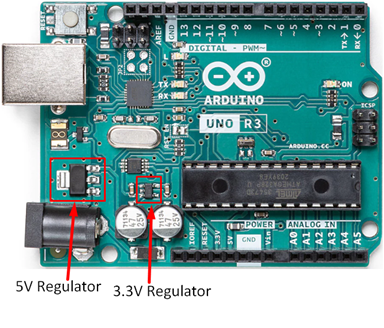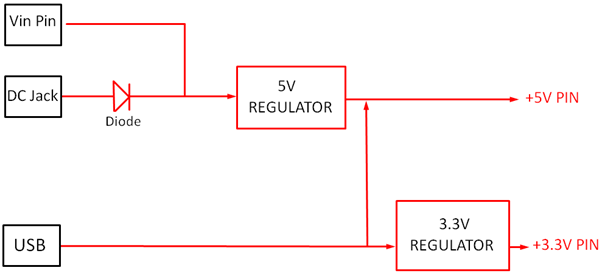Does Arduino Uno Have a Voltage Regulator
Yes, the Arduino Uno has two voltage regulators. One voltage regulator is of 5V and the other one is a 3.3V regulator. Arduino can take power from multiple sources either it can be USB or an external power supply. USB can provide Arduino with constant 5V, but power given through DC Barrel jack or Vin pin need to be regulated first before Arduino peripherals can use it.
Normally Arduino is powered somewhere between 7-12V. First voltage regulators reduced it down to 5V then fed it to the Arduino circuit. Here voltage regulators remove the excess voltages in the form of heat dissipation. Arduino also has a 3.3V power output pin on board. To get 3.3V the regulated 5V is again passed through a second voltage regulator which reduces 5V further into 3.3V.
Types of Voltage Regulator in Arduino
Two types of voltage regulators are used in Arduino Uno and most of the boards:
- 5V (SPX1117M3-L-5) Regulator
- 3.3V (LP2985-33DBVR) Regulator
Both Vin and DC barrel jack voltage is regulated by a 5V regulator, however USB input voltage is by default 5V, so it is directly passed to the output pin. USB voltage is regulated in case of a 3.3V regulator to provide us with 3.3V output. Following diagram shows a graphical representation of Arduino two built-in regulators.
Arduino 5V Voltage Regulator
SPX1117M3-L-5 is the main voltage regulator of Arduino. It can take up to 20V and convert it down to 5V however it’s not recommended to put a lot of pressure on the voltage regulator by applying more voltage than the required optimum voltage. The sweet spot for a 5V regulator is somewhere between 7-12V. Applying voltage lower than 7V can cause Arduino output voltages to fluctuate because some voltages are lost in heat dissipation while about 0.7 V is taken by diode for reverse current protection. Following table shows a brief description of limits about the 5V regulator.
| Regulator | Minimum Input Voltage | Maximum Input Voltage | Maximum Output Current |
|---|---|---|---|
| 5V | 6.2V | 20V | 1A |
Note: Applying more voltage across Arduino will cause regulators to heat up. Once the heat goes beyond the limit of the regulator it will automatically reset the Arduino board and will keep it off until the regulator reaches its normal state.
Arduino 3.3V Voltage Regulator
In older Arduino boards we need to power them using 3.3V as with change in technology 5V emerges as standard voltage for Arduino boards. Now all new Arduino boards have built-in 3.3V regulators to provide us with required voltage if needed. Also, older boards have too low current limits of up to 50mA but the new 3.3V regulators can go up to a maximum of 150mA. The new LP2985 regulator is a high quality and efficient regulator that can power stuff very easily.
As illustrated above this 3.3V regulator is connected to 5V regulator it reduces the 5V output regulated voltage to 3.3V. Following table shows Arduino LP2985 regulator specifications.
| Regulator | Minimum Input Voltage | Maximum Input Voltage | Maximum Output Current |
|---|---|---|---|
| 3V | 3.58V | 16V | 150mA |
Conclusion
Voltage regulators are important while dealing with Arduino. Multiple power sources are there to run Arduino. While taking a smooth voltage that can run our project is very important. Arduino have two types of voltage regulators that can maintain voltage level, so Arduino don’t burn or heat up. This article will help you to find a good power source considering the voltage regulators requirements.


